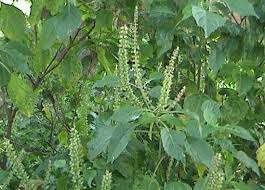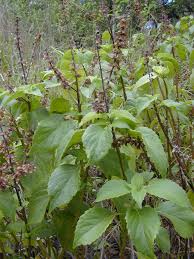Ocimum gratissimum L.
| Botanical Name | Ocimum gratissimum L. |
| Order: | Lamiales |
| Family: | Lamiaceae |
| Genus: | Ocimum |
| Species: | O. gratissimum |
| Common Names: | Tea Bush, mosquito plant, fever leaf, fever plant of Sierra Leone, French: Basilic de ceylan |
Plant Synonyms
Ocimum viride Willd, Ocimum guineense Schum. and Thonn.
Plant Local Names
Cote d'lvoire: Anyi - Samane, Baule - Aloamagneree, Fulfulde - Cunfere
Ghana: Adangme - Gbekona, Akan - Onunum , Ga - Sru Sulu Suru
Guinea Bissau: Crioulo - Doreda
Guinea: Manding Maninka - Su-Guen-Fira
Nigeria: Edo - Aramogho, Hausa – Dai Dooyaata Gidaa, Igbo - Ncho-Anwu Nchuagwunta, Yoruba-efinrin nla
Senegal: Crioulo - Doreda, Fula - Kunfere, Maninka - Sukuru Baba, 'Susu' Barikiri
Togo: Ewe - Dzogbeti, Akaselem - Ditsunonon
Plant Habitat
It is widely distributed in the tropics including Africa and can be found mainly in gardens, compounds, old farms near villages, often cultivated in various parts of West Africa. It is found across many parts of Nigeria, both north and south.
Plant Material of Interest
Leaf, Flower
Plant Description
The plant is an erect shrub that grows up to a height of 1.8 m; the stems are nearly glabrous with leaves, which have rather long petiole, lanceolate to oblong-lanceolate or ovate or obovate, cuneate or asymmetric base, apex acute or acuminate, margin toothed or distantly serrated, up to 12 cm long, 4 cm broad; flowers are cream-white or yellowish, pedicel puberulous, calyx two-lipped, upper lip ovate, lower lip oblong, two-teethed; occurring in paniculate racemes usually 15 cm long with green colour at the bud stage but turns brown when dry (Trease and Evans, 1972).
Plant Used Parts
Plant Uses
O. gratissimum is renowned in African traditional medicine for its use in the treatment of upper respiratory tract (e.g. coughs, pneumonia, etc.) and digestive disorders (e.g. diarrhoea, dysentery), skin diseases, fever, headaches and conjunctivitis (Onajobi, 1986; Oliver-Bever, 1960). It is used as an anticonvulsant and antibacterial agent in the treatment of malaria and small pox (Irvine, 1961). The leaves are used to treat nose bleeding and dizziness, and it is chewed with salt or boiled with it and used as febrifuge and diaphoretic. Fluid obtained by rubbing the leaf with a little water is used as an eye drop for ophthalmic conditions such as conjunctivitis. The leaf infusion is mixed with pepper to treat dysentery (Dalziel, 1936). Oil from the leaves is used to prevent mosquito bites and repel other insects. The leaves are also used to treat constipation, menorrhagia and abdominal colic. The whole plant is used for rheumatism and the root for snakebite (Adjanohoun et al., 1991).
Plant Therapeutic Action
Plant Precaution for Use
Caution should be taken in patients with hypoglycaemia and liver disease. May not be used in chronic constipation; its use in bleeding situations must be medically supervised; overdose or prolonged use may lead to acute constipation and colonic inertial. May irritate mucous membranes when used externally in high doses; pregnancy and lactation.
Plant Adverse Effect
Possible hepatic dysfunction and hypoglycaemia.
Plant Contraindication
Liver disease
Plant Dosage Forms
Infusion; decoction; tincture; essential oil.
Plant Dosage
Decoction: 30 g dried leaves in 900 ml water; simmer until reduced to 600 ml; 1 teacup three times daily
Infusion: 30g dried herb in 600 ml of water; 1 teacupful three times a day
Tincture: 1:5 in 50% alcohol, 5 ml three times daily
Essential oil: 2-3 drops three times daily.
Plant Storage
It should be stored in airtight containers in a cool, dry, dsrk place, protected from light and moisture
Plant Chromatographic Fingerprint
Plant Constituents
Volatile oil (e.g. thymol, eugenol, alpha and (3pinene, camphene, terpinene, limonene and methyl eugenol; camphor, caryophylline); triterpenes; reducing sugars (GHP, 1992; Onajobi, 1986; Sainsbury and Sofowora, 1971; Sofowora, 1970; El Said et al., 1969).
Plant References
Adjanohoun, E. et al., (1991). Contribution to Fakae, B.B., Campbell, A.M., Barrett, J., Scott,
Ethnobotanical and Floristic studies in Western I.M. et al., (2000). Inhibition of glutathione S-
Nigeria" Lagos, Nigeria: The Organization of transferases (GSTs) from parasitic nematodes
African Unity's Scientific Technical and Research by extracts from traditional Nigerian medicinal
Commission, pp293-294. plants. Phytotherapy Research 14(8):630-634.
Aguiy.i J.C., Obi, C.I., Gang, S.S., Igweh A.C. Ghana Herbal Pharmacopoeia (1992). The (2000). Hypoglycaemic activity of Ocimum Advent Press: Accra, Ghana, gratissimurrin rats. Fitoterapia 71(4):444-446.
Iwalokun, B.A., Gbenle, G.O., Adewole, T.A., Ayisi, N.K., Nyadedzor, C. (2003). Comparative Akinsinde, K.A. (2001). Shigellocidal properties in vitro effects of AZT and extracts of Ocimum of Three Nigerian Medicinal Plants: O. gratissimum, Ficus politaClausena anisata gratissimum Terminalia avicennoides and Alchornea cordifoljaand Elaeophorbia drupifera Mormodica balsamina Journal of Health against HIV-1 and HIV-2 infections. Antiviral Population and Nutrition, 19(4):331-335. Research 58(1):25-33.
Ilori, M., Sheteolu, A.O., Omonibgehin, E.A., Daiziel, J.M. (1936). The Useful Plants of West Adeneye, A.A. (1996). Antidiarrhoeal Activities of Tropical Africa London: Crown Agents for the O. gratissimum (Lamiaceae). Journal of Overseas Governments and Administrations. Diarrhoeal Disentery Research 14:283-285.


